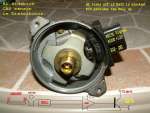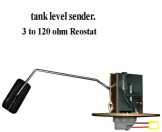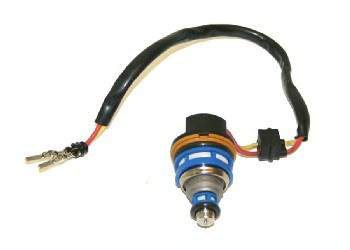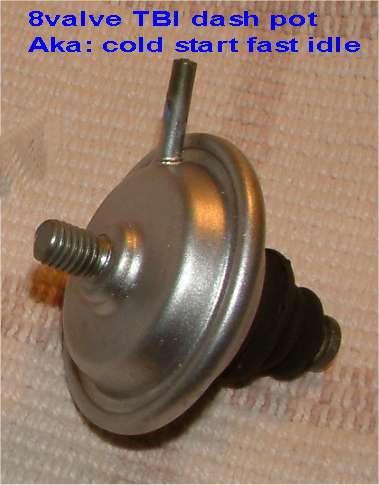
See all Video's, of me testing many of the below sensors and actuators:
Click the photos below 8v ICONS , for the test procedure , For 16V sensors, click the Blue words on the right.
All information below is applicable to 89-98 SideKicks and Trackers.
On newer cars they are very close to the same, and my be moved about.
I try to show the differences between the 8V and 16valve engines much clearer here.
Here is a list of 1996 ohms on all coils (major) (correct resistance VSV valves, relays,etc)
This page is useful if you have and old Suzuki with no scan tool at all 1989-1995 or do have a newer OBD2 car and one sensors reads "FUNNY"
Case in point , the ECT reads 150F but my hand held IR pyro gun shows 180F. oops, it's reading wrong, so I break out my ohm meter (DMM mode, resistance) and check the ohms , connector pulled, on hot engine. (see table by clicking ECT below)
All these parts are easy to hand test, but never the 0² sensor. (I mostly replace any that are suspected but always make sure there are no exhaust leaks near it, sucking air)
One is for Air (IAT) , the other is water (ECT), but the scaling is the same. If you know how to measure a simple resistor , you can test this device too.
The 8valve and 16v EGR look very similar and works the same exact way. This is vacuum operated until 1998.
Idle Air controller. (is just a simple electromagnet solenoid air valve)
This device controls idle at all times, hot or cold. It is modulated (200 times a second) by the ECU, (PWM) to set the correct idle speed. We set its duty cycle.
The 16v part looks different but in fact, works the exact same way. The 8v and 16v has the nipples bend differently but are the same 91-98'
The hot water feed does not change this device, the hot water is to heat the Throttle body and/or intake manifold, for better cold start running.
The ECU sets hot idle speeds at all times, using this device as a slave. we set only the duty cycle using the TB bleed screw. The ISC also opens real wide for cold and for sure hot starting the engine, if not?, the engine floods.
In cut fuel mode (dropping the accelerator pedal from fast driving) the ECU opens this valve to prevent passenger neck snap actions. (engine compression effects can be a tad brutal)
Aka: Idle Air Controller (electric)The 89/90 has no air tube or water tubes and has just 2 wires
The below, is an Active thermal mechanical device only. It is for cold start and cold running Air ONLY ! At about 150F it is 100% closed.
Idle Air Control (cold start) It is water coolant operated only.
It has no wires, the ECU has zero control of this passive device.
If it sticks open hot?, the engine screams fast.(endlessly)
if it fails to open cold?, the engine floods. (cold start air missing goes rich as piggy)
It can be tested 2 ways, in pan of 180F water, or on car blocking the top air IAC input port with clay. (if this block action lowers idle speeds hot, the device is TOAST)
The TPS, the throttle position sensor, on new cars there are 4 of these, due to Throttle by Wire designs.
TPS idle switch detects idle state. The TPS other side, is the Throttle angle device.
It is mounted to the throttle body, and fits to the throttle valve shaft end.
The TPS is very complex (simple by self) but is used in many complex ways.
(Idle switch, activates the ISC, and kills EGR) and lots more.
It(ECU is it) also detects wide open throttle (WOT) and cuts out the 02 sensors. and goes rich.
It activates Enrich mode , by detecting the drivers fast right foot (preventing short bogs) The ECU looks for the drivers aggresive throttle actions. (drops the 02 sensors and goes to fueling tables. and unique spark timing tables)
The idle switch when closed driving fast, the ECU goes to CUT fuel mode, and controls RPM via the ISC .
THE CAT.
Manifold Air Pressure Sensor. This TBI 8valve EFI device, is the key fueling device. It is used to Calculate air flow through the engine. (with the aid of the IAT)
This device is also called a 1 bar, baro sensor. (measures barometric pressure)
Some 16v engines (96+) have a MAP sensor (MDP), but it is ONLY used for testing the EGR function (for EPA monitors)
MAF ( The air meter)
Never touch the hotwire, inside ! (nor blast it close up with MAF cleaner spray tube end, stay back a foot for cleaning Suzuki wants $1200 for one... ouch.) Some clones of this out of China are DEAD.
This MAF device is very accurate measuring true air flow through the engine. If it goes dead , you get no engine power to speak of, if dead the ECU will very poorly attempt to mimic it . (+ failsafe penalties)
In fact, most dead sensor on the page, the ECU will attempt to mimic, if dead. (aka. simulate in failsafe mode)
The OXY sensor is very hard to test. It just hates exhaust leak, and lasts about 100k miles. There is no true test for it, besides, (it's dead, or it seems to have some life in it)
This too is a key sensor. It must not stick low at 0v. or the ECU will go way rich, with fouled black spark plugs and horrid low MPG. Click the ICON for more horrors...
VSS !
Vehicle SPEED sensor called VSS and all IP cluster issues click the below ICON.
The 4speed car has 2 ,VSS sensors, one in the head below and one at the tranny tail shaft.
If the 4speed, VSS fails the TCM fails over to the speedo head VSS.
On newer cars, there is just one VSS on the tail of the transmission (or transfer case end) (my JK Jeep has 6 speed stick trans and no VSS at all , it uses ABS sensors for speed, (for free, see that magic?)
The VSS is not optional the ECU uses road speed, and engine load, RPM and Air flows to calculate Fueling and spark advance, it this sensor is missing , you will lack power, on some ECU you go to FAILSAFE MODE.
This photo is joke, but we all see it, in real life..
There are other devices, important to the engine operation , including the Crank and CAM senders. (CKP and CMP)
Which If the CAM sensor (CMP) is dead, all spark will end. When spark ends the PCM ends fueling pronto.
The newer cars 1996+ have both a Cam position sensor, but also a Crank position sensor, motor will run but poorly with Crank sensor dead.
The crank sensor on the G16b allows this new OBD2 engine do monitor misfire OBD testing...at all times running (a federal rule)
Dual senders are necessary on DIS Ignition (Distributorless Ignition System) (1.8L (J18) sport or 2.0L(J20) Vitara engines and larger ) NO DISTRIBUTOR (as early as 1996)
The CKP sensor strobes (timing signals) for the location of , TDC at crank, the other cam sender signals, #1 firing now.
The PCM will in fact tell you (scanned), when one or the other are dead or misfiring with DTC errors P03xx. (even 1 misfire in 10) Even just cranking a dead engine, the PCM will tell you (scanned) which sensors are dead.
The cam sensor. (gear driven)
 The 8v CMP, sender to
the left (click icon zoom) . Click here to see 16v CMP
The 8v CMP, sender to
the left (click icon zoom) . Click here to see 16v CMPThe CRANK sensor called CKP.: (below)
Starting in 1996 (USA) and 98 (Ca
nada) Suzuki added a CKP ,crank sensor to greatly increase timing accuracy to perform OBD2 , spark misfire Monitoring.
The ENGINE TEMPERATURE GAUGE OP's and testings. PER FSM. THIS IS NOT THE ECT !!! This is NOT an ECU sensor at all.
This sender will not effect engine operation, but many people, have trouble with it. Note the SINGLE terminal !
Do not confuse this sensor with the ECT (which has 2 pin) , nor the A/C coolant over heat switch, or the IAT.
The photo to the left is the sender, the photo to the right is the gauge.
If that brass pin is corroded (rusty), that wont work. "clean it with 400 wet dry sand paper"
If the lug to same sender is mangled, dirty, corroded or loose. that wont work either. Correct it.
left is the sensor and right is the Actuator. (these parts are all TOY GRADE, not real instruments at all.
This gauge is not in anyway accurate , it only shows relative temperature of the coolant .
The gauge will read wrong, if air pockets are present near this sender. (rad not full?)
It is about as accurate as a dousing rod. (Toy grade, it has no actual scale , just H and C)
I always use and IR pyro heat gun to read, coolant temperatures. (a $15 tool at Harbor Freight store)
I also have a DMM meter with thermocouple probe that works great too. but the above, no contact (no burns) IR tool guns RULE !
Gas tank fuel Level Gauge testing: ( or the in tank sender)
Sender and gauge shown below (in the lasts years 97 and up, the ECU does look at this sensor, and suspends the EVAP tests, if too full.
This device too, is toy grade, and lies to you most its life.
It is a non linear device.
Most gauges, fail to lower, when from full , until many gallons have been used. (and full varies by your gas stations , auto shut off system)
And at the end, it likes to go to E too fast. (lies to the driver, so they buy fuel faster, and not get stranded,) Some cars on "E" have 3 gallons of fuel in the tank.

Keep in mind, there are different size /depth tanks and different, depth pumps and parts on said tanks, order carefully. 2 door and 4 door Sidekicks, use different size tanks.
A super easy device to test. click testing link above.
Fuel pump: (and Actuator it is)
Click image so see my fast pump testing page.

Here is my Full Pump testing page ,including he pressure checks.
The fuel filter must not be clogged , this filter has a 6mm side test port and will have about 34 PSI , key on. ( if you read 41 PSI the filter is clogged)
My filter is clogged now and reads 44 PSI running, a new filter and retest it reads 33 PSI running. ( clogged filters , kill fuel pumps as does running them dry)
The Pump is gasoline cooled and is gasoline lubricated, never ever run any MPI/TBI car dry of gas.
More Actuators:
 Injector(s).
This one is a TBI 8v injector.
Injector(s).
This one is a TBI 8v injector. MPI 16v
MPI 16vThere are few simple tests for the injectors, save sending them out for cleaning and tests.
Click the photos for full details off all tests.
Never apply 12vdc to either injectors , this will burn up the coils inside. This is called letting the smoke out!
The 2 injectors are PWM modulated at all times, and never at 100% duty cycle ever.
The TBI is a 1 ohm injector, never connect it to a battery of any kind. It will smoke in 1 second flat , hot wired.
The MPI is about 10 ohms. and draws 14 watts at 100% duty. That is too hot. We use an injector pulser to do by hand injector tests.
How ever some folks do use a small 9v transistor battery to test it directly, the (9v battery over loads first. saving you from the smoke testing)
The injector may or may not open (9v),depending on the type of 9v battery used. (of the many kinds sold today) (listen to clicks with the battery touched fast?)
Listing for the injector to click ,check the ohms. use a NOID lamp.
A DIY pulse is here. (555 timer heaven) (sold in stores for $100)
I Bench test mine using and old Ford ECU. (fooled to think it has an engine connected)
Best is to send them here.
For reverse ultra-sonic cleaning, and the hidden internal 10 micro screens too.
Actuator VSV
Vacuum Solenoid Valves.
How to test this valve is here:
Uses for EVAP, EGR and dash pot servo (8v)
One extra VSV (only on 8-valve engines) controls the 8V Dash Pot which is the cold start fast Idle function. VACUUM SOLENOID VALVE = VSV)
One VSV runs the below.
The Dash pot is only found on 8V cars and is only for cold start fast idle , it must be retracted after 3 to 30 seconds, after starting motor. (time varies by coolant temperature)
This device holds (physically) open the throttle , even with the key turned off. When you start the car the ECU commands the VSV to open and vacuum then retracts this device.
Then Idle drops, to the fast idle rate dictated by the IAC, after 150 Degrees F is reached the IAC is closes and the ISC and idle bleed (adj) screw , determine idle.
This DP has a spring in side that pushes the throttle open by default.(key off)
The FULL TEST OF THIS DEVICE and even a Video is here.

The Dash pot function is done purely in software on the 16v cars. The 16v cars has no physical dash pot. see the video, of it working.
The 16v opens the ISC 100% and adds huge starting air. making this part obsolete.
Relays: FIND THE HERE.
This page covers all ECU related sensors and actuators, but does not cover the Fuel pump relays or the EVAP2 1997 and newer cars.
For the fuel pump relay see this.
The main relay bad, the ECU goes TOTALLY dead. and no CEL lamp on dash cluster.
The EVAP system uses VSV valves. seen above, and the tests above on VSV are valid.
For the EVAP 2 page try this.(97+)
EVAP1 is covered too. 1996.
The FPR (fuel pressure regulator) the 8v reg blow, compensates for Altitude only. That FPR hose below is wrong, it's really air horn pressure, sorry)
The 16v FPR compensates for that and the fact that the 4 injectors are buried in the vacuum plenum. (and MPI thing) That VAC hose on 16v is real plenum vacuum at all times. (0 inches HG to 26"HG, changing under engine load)
The MPI Reg, has low fuel pressure at idle and rises to over 40psi at wide open throttle, if not?, the engine fueling starves and bogs)
The PPR loves to fail this old, now. sticks inside. Kick it to the curb if suspected. Mounted to the front of 8v throttle body, or on 16v the fuel RAIL.

Click the image above to see all about this device ( actuator)
There are 3 tests , the leak down tests, and fuel regulation tests.
The 8v FPR is only for altitude, VAC above is wrong, it's air cleaner side pressure. (it can also compensate for a dirty air cleaner in this case it does go to vacuum levels with a packed filter)
The 16v FPR is a very very critical part on the 16valve MPI engine, it controls injector pressure that rises 6pis as you hit wide open throttle and at the same time compensates for altitude.
ver9 12-1-2010 (added CPK) and video tests of leak down and TPS 8-20-2015 edits. and more links.
JARGON page.